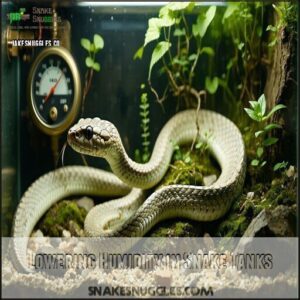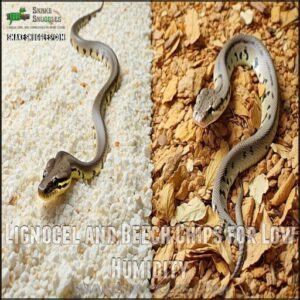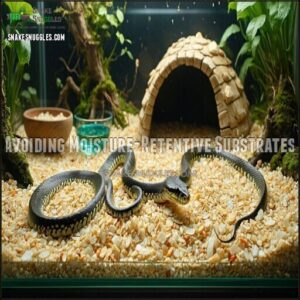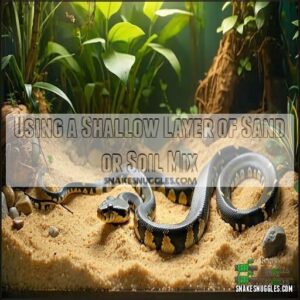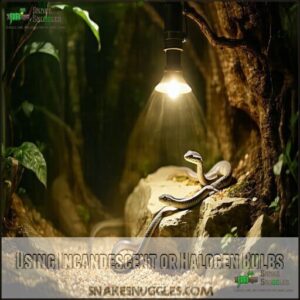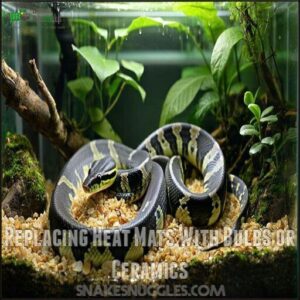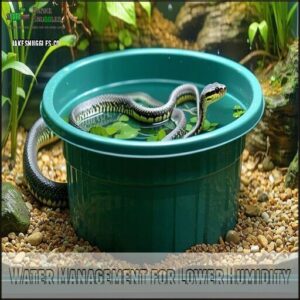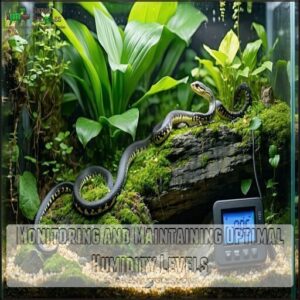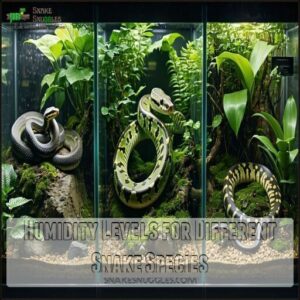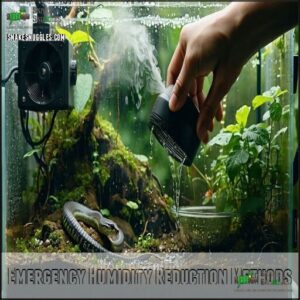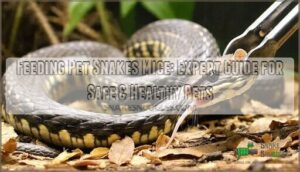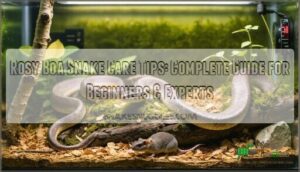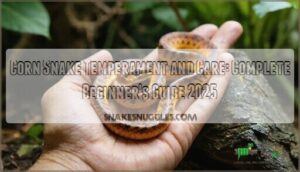This site is supported by our readers. We may earn a commission, at no cost to you, if you purchase through links.
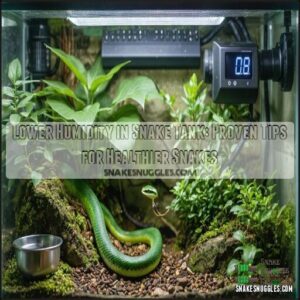 To lower humidity in the snake tank, start by improving ventilation—swap the lid for a mesh screen or add ventilation holes.
To lower humidity in the snake tank, start by improving ventilation—swap the lid for a mesh screen or add ventilation holes.
Use a dry substrate like Aspen or paper bedding, and avoid materials like coconut fiber that hold moisture.
Keep the water bowl on the cooler side of the tank or try a smaller one to limit evaporation.
Heat sources like ceramic bulbs can help dry the air, and increasing room airflow with a fan or using a dehumidifier works wonders.
Monitor levels with a hygrometer to stay on track. Little changes make a big difference in keeping your snake comfortable!
Table Of Contents
- Key Takeaways
- Lowering Humidity in Snake Tanks
- Choosing The Right Substrate for Low Humidity
- Reducing Humidity With Lighting and Heating
- Water Management for Lower Humidity
- Monitoring and Maintaining Optimal Humidity Levels
- Humidity Levels for Different Snake Species
- Emergency Humidity Reduction Methods
- Frequently Asked Questions (FAQs)
- What is the Best Substrate for Lowering Humidity in a Snake Tank?
- How Often Should You Check the Humidity in the Tank?
- What Are the Health Risks of Having Too Low Humidity in a Snake Tank?
- Are There Any Natural Methods to Raise Humidity in a Snake Tank?
- What Are the Signs of Too Much Humidity in a Snake Tank?
- Is 80% humidity too high for ball pythons?
- What happens if a snake has too much humidity?
- How do I decrease the humidity in a terrarium?
- How much humidity should be in a snake tank?
- What happens if humidity is too high for snake?
- Conclusion
Key Takeaways
- Improve airflow by using a mesh lid or adding ventilation holes to the tank.
- Place a smaller water bowl on the cool side to limit evaporation and lower humidity.
- Use dry substrates like aspen shavings or paper towels to prevent moisture buildup.
- Monitor with a digital hygrometer and make quick adjustments like adding a fan or reducing water sources if humidity gets too high.
Lowering Humidity in Snake Tanks
Keeping your snake’s tank at the right humidity level is essential for their health and comfort.
Maintaining the perfect humidity ensures your snake stays healthy, comfortable, and thriving in its enclosure.
High humidity can lead to serious issues like scale rot and respiratory infections, so it’s important to monitor conditions and make adjustments when needed.
Identifying High Humidity Issues
Too much humidity in a snake tank can cause real problems, so watch for these telltale signs:
- Condensation signs—fogged-up walls or droplets indicate excess moisture. Tank condensation is a major warning.
- Musty odors—a moldy smell means trouble; excessive moisture often creates bacteria-friendly conditions.
- Soggy substrate—damp or wet bedding points to a humidity imbalance. Substrate dampness stresses your snake.
- Visible mold—spotted any green or white fuzz? Mold on substrates or tank surfaces is a clear red flag.
Monitor the space regularly with a hygrometer for precise humidity readings. Avoid neglecting airflow—it’s essential for humidity control. Catching these issues early helps prevent harm to your snake, keeping their habitat safe and comfortable!
Recognizing Scale Rot and Respiratory Issues
Excess moisture can harm your snake’s health, leading to issues like scale rot and respiratory infection.
Scale rot ID involves checking for symptoms like scabby scales, fluid-filled blisters, or discolored belly skin. For respiratory symptoms, watch for wheezing, open-mouth breathing, nasal mucus, or lethargy.
Since the snake respiratory tract is sensitive, untreated respiratory infections quickly worsen. Prevention is key—manage humidity carefully and make certain proper ventilation.
If signs appear, act fast. Seek veterinary intervention to protect both snake health and snake skin health from further complications.
Understanding The Risks of Chronic Dehydration
Dehydration dangers in snakes can cause serious health problems, including kidney damage, shedding problems, and weakened organ function.
Low humidity risks, like dysecdysis (shedding issues), leave your snake vulnerable to long-term effects, including immune system issues.
Watch for snake dehydration signs such as saggy skin, sunken eyes, or sluggish behavior.
Use a hygrometer to track humidity, as improper conditions heighten dehydration risks.
Balancing humidity is key—don’t overcorrect, as extreme dryness or sudden shifts can stress your snake.
If dehydration signs appear, act quickly to prevent kidney issues and maintain snake health.
A well-monitored habitat keeps your snake thriving and comfortable.
Choosing The Right Substrate for Low Humidity
Choosing the right substrate is key to keeping humidity levels low in your snake’s enclosure.
Opt for materials like aspen shavings or beech chips, which help absorb moisture without retaining it, to achieve low humidity levels.
Lignocel and Beech Chips for Low Humidity
Dealing with a damp snake tank? Lignocel and beech chips are lifesavers! These drier substrates combat humidity effectively while keeping your pet cozy and healthy.
Here’s how they stand out:
- Mold Resistance: Lignocel stays clean longer and resists bacterial buildup.
- Minimal Moisture Absorption: Beech chips don’t hold water, ensuring a dry environment.
- Snake Comfort: Both substrates prevent sogginess, maintaining health and activity.
They’re affordable, widely available, and simple to clean. You can find various Lignocel products online for snake bedding. Add solid airflow, and you’ve got a winning combo against low humidity risks in snake tanks.
Avoiding Moisture-Retentive Substrates
Choosing the right snake tank substrate can make a world of difference in managing humidity. Steer clear of moisture-retentive materials like coir fiber, bark chips, or leaf litter.
They soak up water, raising humidity levels and potentially leading to issues like mold, respiratory infections, or scale rot.
For a drier substrate, go with aspen shavings or paper towel bedding. Both options are fantastic for drainage and maintaining a balanced environment.
Wondering about Aspen vs. Cypress? Aspen shavings are the better pick for dry conditions, while cypress holds moisture—great for tropical species but not ideal here. Many owners buy quality aspen bedding for their snake enclosures.
Another pro tip: use a shallow layer of substrate. It makes spotting and removing damp patches much easier, keeping your tank fresher. With the right substrate choice, like lignocel, you’ll guarantee a safe, breathable space for your snake.
Using a Shallow Layer of Sand or Soil Mix
If you’re avoiding moisture-retentive substrates, consider switching to a shallow layer of sand or a soil mix. Both materials improve snake tank humidity control by promoting dryness and reducing substrate moisture. They also support natural burrowing behavior in many species.
A thin layer of sand (1-2 inches) offers great aeration benefits and easier cleaning. Combining sand with soil in a 2:1 ratio enhances drainage improvement while maintaining stability to prevent clumping. This combination reduces mold risks and supports root health for any live plants in the enclosure.
Coconut husk benefits include excellent water absorption if you choose to include it in small quantities.
-
Key advantages include:
- Better drainage improvement for a drier environment.
- Improved mold prevention and aeration benefits.
- Reinforced burrowing behavior without excess moisture.
This setup creates a functional and natural habitat your snake will thrive in!
Reducing Humidity With Lighting and Heating
You can effectively lower humidity in your snake’s tank by adjusting lighting and heating setups.
Switching to heat bulbs or ceramic heaters and creating airflow helps reduce excess moisture in the enclosure.
Using Incandescent or Halogen Bulbs
Struggling with high humidity in your snake’s tank? Incandescent and halogen bulbs might be the solution. These heat sources effectively lower humidity by increasing evaporation rates while keeping the air dry. Picking the right bulb wattage guarantees safe, efficient heating and helps create a proper basking spot.
Focus on placement to maintain a balanced heat gradient, meeting your snake’s needs without overheating. Incandescent bulbs provide moderate heat and a basic light spectrum, while halogen bulbs offer high heat intensity and a natural, sun-like glow. Remember to examine overhead heating options for effective sunlight simulation.
Halogen options also have a longer bulb lifespan, making them cost-efficient.
| Feature | Incandescent | Halogen |
|---|---|---|
| Heat Intensity | Moderate | High |
| Bulb Lifespan | Moderate | Longer |
| Energy Efficiency | Low | Higher |
Replacing Heat Mats With Bulbs or Ceramics
Switching heat mats for ceramic heaters or bulbs is a smarter way to control humidity in your snake tank.
Ceramic heat bulbs provide steady warmth without light, making them ideal for nighttime comfort. Halogen or incandescent bulbs lower humidity while maintaining an even heat gradient.
Many owners source their reptile heating products online.
- Pro Tip: Use a thermostat to manage energy consumption and avoid overheating.
Place your bulbs securely, ensuring proper ventilation for balanced warmth and safe heat source effect. Skipping this step? That’s a slippery slope!
Creating Convection Currents to Dry The Air
Convection currents are a smart way to keep humidity under control in your snake tank.
When your heat source, like a ceramic bulb, warms the air, it naturally rises, letting cooler air flow in to replace it.
This constant airflow direction reduces moisture effectively.
Focus on proper airflow management—use mesh lids or ventilation holes to let humid air escape, and position heat sources near areas that retain moisture.
Adjust enclosure height to support better temperature gradients, optimizing natural convection.
Regular airflow and ventilation fine-tune the humidity balance, creating the perfect environment for your snake.
Think of it as nature’s built-in dehumidifier!
It is essential to maintain proper airflow management to keep the environment healthy for your snake, ensuring proper airflow and ventilation are key to a successful snake tank, with humidity balance being crucial.
Water Management for Lower Humidity
Managing the water in your snake’s tank is key to keeping humidity levels in check.
A smaller water bowl and strategic placement can help minimize evaporation and prevent excess moisture buildup.
Using a Smaller Water Bowl
Reducing snake tank humidity can be as simple as choosing the right-sized water bowl. A smaller bowl reduces the evaporation surface area, giving you better control over the enclosure’s humidity levels without sacrificing your snake’s needs.
Here’s what to look for in a water bowl:
- Size matters: Use the smallest bowl that allows your snake to drink easily.
- Pick sturdy materials: Ceramic or heavy-duty plastic prevents tipping.
- Refill daily: Regular cleaning and fresh water maintain hygiene and reduce bacteria.
- Consider bowl placement: Keep it in a spot that minimizes heat exposure.
This straightforward adjustment helps with humidity control while ensuring your snake stays hydrated and healthy.
Placing The Water Bowl at The Cool End
Placing the water bowl at the cool end of your snake tank is a simple but effective way to master humidity control.
When positioned on the tank’s cool side, the bowl slows water evaporation and maintains a healthy humidity gradient. It’s all about working with the natural temperature gradient in your setup.
Here’s a quick breakdown in table form:
| Bowl Location | Evaporation Rate | Humidity Impact |
|---|---|---|
| Cool End | Low | Prevents condensation |
| Warm End | High | Increases tank humidity |
| Near Heat Source | Very high | Promotes excess moisture |
| Middle Area | Variable | Unpredictable outcomes |
By sticking with a cool-end placement, you reduce evaporation naturally, minimizing risks like condensation and excess moisture.
Using a hygrometer helps to monitor humidity levels and confirm they remain in the ideal range. Need to tweak? Monitor your hygrometer readings and adjust placement to stay in control of that perfect balance your snake needs.
Minimizing Evaporation and Humidity Increase
Managing snake tank humidity starts with controlling evaporation effectively. Small changes can lead to big improvements.
- Choose a smaller water bowl to limit evaporation surface.
- Place the bowl on the cooler side of the tank, away from heat sources that speed up evaporation.
- Check ventilation strategies to confirm proper airflow, which helps reduce trapped moisture.
Avoid over-misting your snake’s habitat unless it’s shedding, and consider dehumidifying methods if needed. These simple adjustments make a noticeable difference, keeping both humidity control and your snake’s comfort in check.
Monitoring and Maintaining Optimal Humidity Levels
You’ll need to keep a close eye on humidity levels to create a safe, healthy environment for your snake.
Using a reliable hygrometer and placing it strategically guarantees you can make accurate adjustments when needed.
Using a Reptile Hygrometer for Accurate Readings
A reptile hygrometer is your go-to gadget for monitoring humidity. For accuracy, pick a digital hygrometer—its real-time display beats analog options.
Guarantee reliable readings by calibrating the probe periodically and placing it at or near ground level in your tank, away from heat sources. Using multiple hygrometers? Smart move! Place them in different spots for broader coverage.
Here’s a quick comparison:
| Hygrometer Type | Advantage | Ideal Use |
|---|---|---|
| Digital Hygrometer | Easy-to-read | Everyday monitoring |
| Analog Hygrometer | Budget-friendly | Backup tool |
| Probed Digital | High precision | Difficult spots |
Stay precise! Ensure you have the right tool for the job, whether it’s a digital hygrometer or an analog one, to maintain the perfect environment for your reptiles.
Placing Hygrometers in Strategic Locations
Humidity measurement starts with smart hygrometer placement. Accuracy isn’t just about having a device—it’s about where you put it.
For ground-dwelling snakes, place the probe near the substrate. For arboreal species, mount it halfway up the enclosure. Unblocked sensors mean better readings.
- Use multiple hygrometers for various enclosure areas.
- Put one on the cool side for balanced readings.
- Regularly check for obstructions, ensuring both analog and digital devices work smoothly.
Adjusting Humidity Maintenance Based on Readings
Hygrometer placement is vital for snake tank humidity control. Check readings daily, and calibrate hygrometers regularly to guarantee accurate results.
Placing multiple hygrometers in different areas helps you interpret variations in humidity levels effectively. If readings show an issue, act promptly: reposition water dishes, reduce their size, or improve ventilation.
Adding a heat source like halogen bulbs can aid in humidity adjustment. Keep an adjustments log to track what works, as small tweaks now prevent long-term problems, keeping your snake healthy and its environment balanced.
Humidity Levels for Different Snake Species
Every snake species has specific humidity needs that reflect its natural habitat. By understanding these requirements, you’ll help keep your pet healthy and its environment comfortable.
Humidity Requirements for Ball Pythons
Ball pythons need 50-60% humidity for good health. Stray too far, and you’ll risk shedding issues or worse, respiratory health troubles like infections or scale rot.
- Keep a digital hygrometer handy: It guarantees accurate readings for snake enclosure humidity reduction.
- Briefly increase humidity during sheds: Aim for 70%, but don’t overdo it or mimic a sauna!
Creating a balance mimics their natural habitat while avoiding pesky tank problems. Using cypress mulch substrates can aid in maintaining proper humidity.
Humidity Needs for Other Pet Snake Species
Every snake species has unique humidity requirements to stay healthy.
Tropical varieties like Boa Constrictors need higher humidity (50-70%) for shedding needs and respiratory health.
In contrast, Desert Species, such as Western Hognose Snakes, thrive in drier environments with humidity levels between 30-50%.
Temperate snakes like Corn Snakes, Milk Snakes, and California Kingsnakes are happiest at moderate ranges of 40-60%.
Here’s a quick guide:
| Snake Species | Humidity Range (%) | Notes |
|---|---|---|
| Boa Constrictor | 50-70 | High humidity supports skin and lungs |
| Western Hognose Snake | 30-50 | Prefers dry, well-ventilated enclosures |
| Corn Snake | 40-60 | Moderate humidity prevents dryness |
| Garter Snake | 45-55 | Needs balanced wet and dry zones |
| Milk Snake | Below 50 | Low humidity avoids skin infections |
Using a hygrometer, monitor your snake tank humidity carefully.
Balance is critical—too much moisture harms your snake enclosure by promoting mold or health issues.
Keep your snake species’ humidity needs front and center to guarantee their well-being.
It is essential to maintain the right humidity level to prevent health issues and ensure the snake’s respiratory health.
A quick guide like the table provided can help you determine the ideal humidity range for your snake.
Remember, moderate humidity is often the key to a healthy snake environment.
By following these guidelines and using the right tools, you can create a comfortable and healthy environment for your pet snake.
Understanding The Importance of Species-Specific Humidity
Nailing down the right species-specific humidity is essential for your snake’s health. Each species has unique humidity requirements that mimic their natural habitat. Some, like corn snakes, need drier environments. Others, such as tropical pythons, thrive in moist enclosures.
- Habitat Mimicry: Research your snake’s natural environment to meet ideal humidity levels.
- Regular Monitoring: Use hygrometers to track and adjust snake tank humidity effectively.
- Watch for Health Indicators: Trouble shedding, breathing issues, or skin changes could mean poor snake enclosure humidity control.
Tailoring your approach guarantees respiratory health and shedding success!
Emergency Humidity Reduction Methods
When your snake tank’s humidity gets too high, acting quickly is essential to protect their health.
Simple methods like increasing air circulation or removing damp decorations can make a big difference fast.
Using Fans to Increase Air Circulation
Fans can quickly reduce humidity and improve snake tank air circulation. With the right setup, they help maintain a safe, comfortable environment.
Follow these steps:
- Fan Placement: Position the fan 6–8 inches above the substrate for effective airflow without disturbing your snake.
- Fan Types: Small desk fans work best to avoid overwhelming your snake.
- Airflow Direction: Angle the fan for indirect ventilation to evenly distribute air.
- Timer Usage: Set a timer for consistent operation without overcooling the enclosure.
- Noise Levels: Use a quiet fan for stress-free snake tank ventilation.
Monitor airflow with a hygrometer for balanced humidity.
Removing Moisture-Retentive Decorations
Got a humidity problem? Moisture-retentive decorations might be the culprits! Some materials trap water, boosting snake tank humidity and inviting mold.
Here’s what to avoid:
- Live plants: While attractive, they release moisture constantly.
- Driftwood: Absorbs water and acts like a sponge.
- Moss-filled hides: Cozy but excellent at trapping dampness.
- Fake plants: Designs with hollow pockets hold hidden moisture.
Replace porous decor with sealed, mold-resistant alternatives. These changes simplify cleaning frequency and support proper ventilation, aiding snake tank dehumidification!
Implementing Quick Fixes for High Humidity
Humidity creeping up? Take immediate action! Place a fan near the snake enclosure for a ventilation boost, or open the lid briefly for airflow.
Take swift action—boost ventilation with a fan or open the lid briefly to keep your snake’s habitat perfectly balanced!
Temporary relocation of water bowls to cooler spots reduces evaporation. Switch to absorbent materials like dry paper bedding and skip misting.
For quick fixes, a dehumidifier or even a rice sock can soak up excess moisture.
Always double-check your hygrometer readings to confirm proper ventilation and maintain proper humidity control for your snake’s health.
Frequently Asked Questions (FAQs)
What is the Best Substrate for Lowering Humidity in a Snake Tank?
Aspen shavings and paper towels are fantastic for keeping humidity low in your snake’s tank.
They absorb less moisture and prevent excess buildup, helping you maintain a balanced, dry environment for your slithery friend.
How Often Should You Check the Humidity in the Tank?
Imagine your snake’s hygrometer suddenly reads too high—regular checks prevent surprises like that.
You should check humidity daily, especially during shedding cycles, to guarantee your snake’s environment stays just right for their health.
What Are the Health Risks of Having Too Low Humidity in a Snake Tank?
Too low humidity risks your snake’s health, causing dry skin, dehydration, or incomplete sheds.
Over time, this leads to stress and potential infections.
Keep an eye on it to guarantee your pet stays comfortable and thriving.
Are There Any Natural Methods to Raise Humidity in a Snake Tank?
Did you know some snakes need 60-70% humidity to thrive?
Boost levels naturally by misting with water, adding live plants, or placing a larger water bowl near a heat source.
It’s that simple!
What Are the Signs of Too Much Humidity in a Snake Tank?
Too much humidity shows up as condensation on walls, a damp or moldy smell, or even scale rot on your snake.
It can also lead to respiratory issues—watch for wheezing, lethargy, or appetite loss.
Is 80% humidity too high for ball pythons?
Ball pythons prefer 60-70% humidity.
At 80%, you risk respiratory issues or scale rot.
Keep levels steady with better airflow or smaller water dishes.
A slight rise is okay during shedding, but not long-term, as this can lead to issues such as respiratory problems if not properly managed.
What happens if a snake has too much humidity?
If a snake’s humidity stays too high, it can develop scale rot, respiratory infections, or even moldy spots in its enclosure.
Keep it balanced to avoid these health risks and guarantee a happier, healthier snake!
How do I decrease the humidity in a terrarium?
Move the water dish to a cooler spot, use a smaller bowl, and switch to drier substrates.
Add ventilation with a mesh lid or vents.
For stubborn humidity, try a room dehumidifier.
How much humidity should be in a snake tank?
Humidity levels depend on your snake’s species.
Tropical snakes need 60-80%, temperate ones prefer 40-60%, and desert snakes do best around 20-40%.
Research your snake’s natural habitat to verify its enclosure matches those conditions, ensuring you provide the best environment for your pet, with proper care.
What happens if humidity is too high for snake?
When humidity’s too high, it’s like a damp sponge breeding problems—your snake risks scale rot, respiratory infections, and moldy enclosures.
Too much moisture stresses them out, so keep it balanced for their health.
Conclusion
Did you know that a snake’s health can decline in just days if tank humidity isn’t controlled?
To lower humidity in the snake tank, focus on proper ventilation, dry substrates, and strategic water placement.
Use heat sources like ceramic bulbs and monitor with a hygrometer for precision.
These small adjustments guarantee your snake’s comfort and long-term health.
With consistent effort, you’ll create a thriving environment that aligns with their natural needs, and your snake will thank you—happily, in its own way, ensuring a happy and long-term health.

